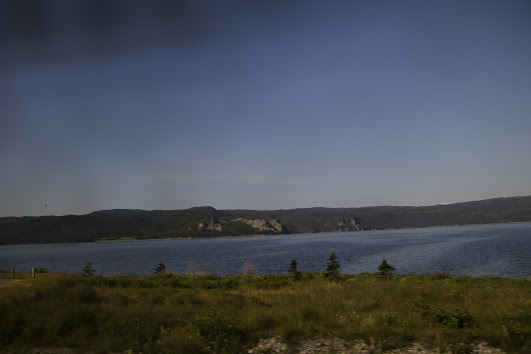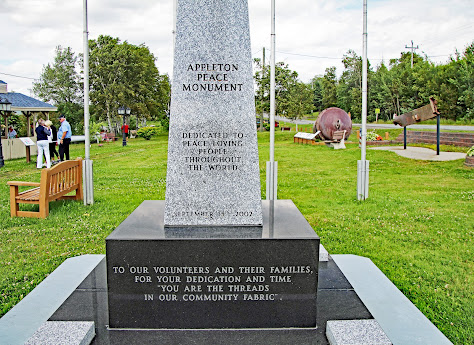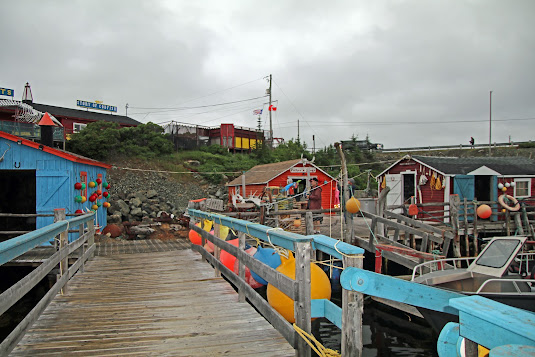2023
NEWFOUNDLAND/LABRADOR BLOG
INTRODUCTION
I will be traveling to Newfoundland and Labrador on
July 21, 2023, for a 10-day tour with Globus Tours. The actual tour begins July 23; however,
since I will have a 4 ½ hour time difference and an all-night flight to Corner
Brook, Newfoundland, I decided to have an extra day to recover from the trip
before the tour formally begins. I hope
you enjoy my observations as I journey around the province.
DAYS 1-3, JULY 21 - 23, 2023-TRAVEL TO CORNER BROOK, NEWFOUNDLAND
The day finally arrived for my departure to Newfoundland. It was a very busy and hectic couple of weeks before I headed out, but I believe I got most of the things done that “had” to be done. LOL. I departed PHX at 4 p.m. on Friday, July 21 and landed in Corner Brook, Newfoundland at 1:40 p.m. local time after a long 5 hour layover in Los Angeles and another 3 hour layover in Toronto. All of the flights operated on time and were full.
It took over
an hour to get into my room when I arrived, but when I finally got into it, I
began getting acclimated to the local time zone which is 4 ½ hours ahead of the
Phoenix time and to catch up on sleep that I missed out on the past 48
hours. By Sunday I was in good shape and,
after getting a couple of doughnuts and a cappuccino at the local Tim Horton’s
(a food chain found throughout Canada), I was ready to take on the day. To begin my adventure, I climbed a hill near
the hotel to get 2 geocaches. Bagging these added another Canadian province to
my statistics, and they were the first caches I have found in the eastern part
of Canada. I was able to drop a couple
of travel bugs in the second cache, one of which was mine and the other was one
that I had found some time ago and it needed to continue its travels with
another geocacher.
My first geocache in Newfoundland. Note the AZ Foothills 911 whistle. The first caution at the trailhead was about the wild animals present in the area. Newfoundland has bears, moose, and caribou among other species.
For a little
perspective on this province, we must consider that Newfoundland and Labrador
are considered as one province and is named using both place names. It became the 10th Canadian
province when it joined in 1949. The
population is just over 500,000 with 95% of the population concentrated in
Newfoundland (known as “The Rock”) The mentality in Newfoundland is still quite
insular after being a province for 70 years and their countrymen from other
provinces are frequently referred to as “Canadians”—outsiders from another
nation. They even have their own time
zone here which is ½ hour ahead of Atlantic Time. Fishing was the primary industry here until
it began its decline in the last century as a result of poor resource
management and overfishing of the fisheries.
The fishing industry has diversified as a result of the decline; however,
many people have moved on to other industries for their livelihoods. Despite the new diversity, the Atlantic
Canada provinces experience higher unemployment, higher underemployment, and
lower income than any of the other provinces. Unlike the other provinces, the
Atlantic Canada provinces still find their economies rising and falling as
conditions cause fluctuations in the fisheries and other natural resources.
History
I won’t go
into a lot of history here because a lot of this trip will focus on visits to
historical sites in the province and I will write about it as I go. With that in mind, I will say that Canada’s
first inhabitants arrived in Labrador about 9,000 years ago, camping near the
large rivers and hunting seals and walrus during the summer. They hunted caribou as they went inland. Eventually, they crossed into northern
Newfoundland and established encampments dating back to about 2300 BC. The first Europeans may have explored the
area as early as the 5th century when Brendan the Navigator, an
Irish monk, was thought to have gone through here. The Vikings established a temporary
settlement around AD 1000 in northern Newfoundland which is on our itinerary to
visit, so I will save writing about their visits until later.
The formal
tour of Newfoundland and Labrador begins tomorrow morning so stay tuned to
future posts.
Fish & Chips and a local beer for dinner. Yummm!
DAY 4, JULY 24, 2023: CORNER BROOK
The tour group met for breakfast and
introductions before boarding a bus to see highlights of Corner Brook and to
pick up groceries (think fruit) and snacks at the largest grocery store in west
Newfoundland (NFLD). We won’t have an
opportunity to find similar supplies for several days and were advised to get
them here. The tour guide has been doing
this type of work for many years and seems very knowledgeable about the
province. The 45-member group is
composed of 2 Australians, many Canadians (especially from the Toronto area),
and about 7 or 8 from the U.S. There are
several single folks (all women) in the group.
I know I am back in the North Country when I see these wildflowers!
And it feels, Oh, so good!
Then it was off to the Humber Arm South to see beautiful scenery, small coves, fishing boats, waterfalls from the tall mountains along the route and a good lunch at Myrtles on the Bay, a pub and eatery near the end of the road. We returned to the hotel early to allow everyone to pack up in preparation for a long day tomorrow.
Frenchman's Cove
Lunch Time. Elvis Presley and other notables have found their way here in the past.
Fog moving into Bottle Cove from the Gulf of St. Lawrence
Fast Fact: It is not unusual to see houses with doors to
the outside but no steps leading down from the door. These are known locally as mother-in-law
doors. J
The guide said she is not aware of the reason for this anomaly, but it
was likely due to tax considerations because of the requirements for the doors and/or
the cost that would be incurred to construct stairs that would not be used. Currently, stairs are required to lead down
from the doors that are installed in homes.
DAY 5,
JULY 25, 2023: ST. BARBE
Did I say
that I am glad to be in the north country?
It feels so good! I am loving the
long hours of daylight and, although it is quite hot for this part of the
world, it is much cooler than Phoenix which tied the temperature for the 4th
hottest day yesterday.
We had a beautiful day for the drive up the west coast of NFLD with lots of sunshine and occasional areas of fog. We drove along Gros Morne National Park which is a UNESCO World Heritage Site in the Long Range Mountains. It is known for its exceptional beauty and unique geological features. The park doesn’t have roads into it so we had to observe it from it’s western boundary along the shoreline. It is considered a geological playground where the whole timeline of geology is found. The theory of plate tectonics was confirmed here. For serious hikers, this is a world-class place to go!
GROS MORNE NATIONALPARK
NOTE THE BEE
We drove
further up the coast to Port au Choix which is a national historic site
highlighting archaeological finds of Maritime Archaic and Dorset peoples who
settled here before 2000 BC. In fact,
archeologists have found evidence of people having been here as much as 5000
years ago. Because of its location, it
has been a crossroads of ancient, indigenous, and European cultures through
time. We saw 8 caribou while visiting
the historic site.
CARIBOU
Fast Facts: NFLD is
known as “The Rock” in Canada. Four moose were brought into NFLD in 1904 as a
future source of meat for residents. The
number has now grown to over 120,000.
The government is trying to become 20% self-sufficient for people and
animal foodstuffs. There is very little tillable
land in the province and root vegetables such as potatoes, carrots, and turnips
are grown during the short growing season.
Even animal feed is imported.
DAY 6,
JULY 26, 2023: RED BAY, LABRADOR
We boarded
the ferry for the trip to the mainland.
The ferry docked in Quebec about a 10 minute drive from Labrador. The day had mixed fog and high clouds as we
drove up the coast to Red Bay. Labrador
is 3 times larger than Newfoundland and has about 30,000 residents. Mining is big in the west part of Labrador
and many NFLD residents travel there to work.
(They also go to other mining areas in western Canada.)
The Red Bay
National Historic Site was our highlight for the day. Basque whalers started coming here in the
1500s and whale oil was shipped to Europe for use in lamps. They were the first to import construction
materials to Canada, bringing clay for pottery and roofing materials for their
dwellings. The visitor center had a wonderful exhibit about the early settlers
in the area and it also showed a lot about the ships used by the whalers since
one in very good shape had been found years ago on the sea floor in the area. Three-mast ships
were used to transport workers and take the oil back to Europe. The population of Red Bay at its height in
the 1500s was estimated at 3,000—now it is about 120 with 80% of the residents
retired.
The oldest
known funeral monument in the New World is found in Red Bay. It is a mound of
rocks marking the burial place of an Indian child who died about 7500 years
ago. The Maritime Archaic people, to
whom the child belonged, occupied this area between 9000 and 3500 years
ago. The body was covered with red
ochre, wrapped in skins or birch bark, and placed in a large pit about 4 ½ feet
deep. Fires were lit on either side of
the body, and several spearheads of stone and bone were placed beside the head.
A walrus tusk, harpoon head, paint stones and a bone whistle were also placed
with the body.
I found a geocache
outside the visitor center—my one and only in Labrador.
We made a
stop at Point Amour Lighthouse Provincial Historical Site, the second highest
lighthouse in Canada and the light still works.
There was an amazing map display at the lighthouse focused on maps from
very early primitive maps to the present day.
I could have spent a lot more time there.
Labradorians call this “The Big Land” and I find that a very fitting description. It is wild country where we were with mountains, quite a few trees in areas and barren in other areas. We stopped at one place to observe boulders, known as errata, left by icebergs. Much of the landscape was rocky and we saw a lot of ponds, streams/rivers and bogs on our short (+/- 50 miles) drive up the coast.
ERRATA
Fast fact: The last significant snowfall at Red Bay was
the third week of June.
DAY 7, JULY 27, 2023: RED BAY, LABRADOR TO ST. ANTHONY, NEWFOUNDLAND
It was very
foggy when we crossed the Labrador/Quebec border enroute to the ferry but we
stopped for a photo anyway. We didn’t
have time to do it on the trip up to Red Bay yesterday.
The ferry
trip was through choppy water, so I had find my “sea legs” to walk about the
boat. The fog dissipated midway through
the trip and we had good weather the rest of the day. A thunderstorm hit just after we got into the
hotel which was fortuitous.
We drove
along the coastline of the Great Northern Peninsula. The trees were very small, as was the
underbrush. It looks like the weather is
very harsh everywhere here. Towns are
small and mostly have “cove” in their names.
Our guide told us that if there is a large house in one of these towns, it
is a sign that the owner commutes to Alberta or elsewhere out west to work and
he makes enough money there to build the big home. Nearly all homes that I have seen on the trip
so far have vinyl siding and have a variety of bright colors.
We stopped
at L’Anse aux Meadows which is as far as you can drive up the Northern
Peninsula. This is where the Vikings
first came ashore more than 1000 years ago—the first Europeans to step foot in
North America. The area was identified
in the 1960s by a Norwegian scholar/explorer and his archeologist wife after
being led to the site of small mounds by a local fisherman. Digs have uncovered eight complexes of
rudimentary houses, workshops with fireplaces, and many artifacts that verified
the Norse presence. It is believed the
Norse were at the location less than a decade.
L’Anse aux Meadows
We took a
short drive beyond St. Anthony to Goose Cove to see another iceberg which was
quite close to shore before calling it a day.
There is a
dictionary, sold in nearly every shop we have been in, with about 2000 words
translating Newfoundland words to English.
DAY 8, JULY 28, 2023: ST. ANTHONY TO ROCKY HARBOUR (GROS MORNE AREA)
Last night, as I was getting my
computer set up to do some work, the screen started separating from the top
cover. It was an “Oh, no!” moment. The plastic border around the screen was
separating and the two hinges connecting the top of the computer to the bottom
were not functioning correctly. I went to the front desk to see if they had any
duct tape on the premises and the lady there reached under the counter and
handed me a large roll of tape. I taped the border around the screen and
reinforced a few areas and everything seems to be working okay. It is not
pretty, but it works and that is what matters.
We made a
brief stop at Arches Provincial Park to see arches that have been eroded
into a rock stack that sits along the rocky beach. Much of the underlying
bedrock along the coast is limestone and studies have revealed that this area
as well as the Long Range Mountains was once part of the ancient Appalachian
Mountains now found in the U.S.
Continuing down the coast in Gros Morne National Park (a UNESCO World Heritage Site) we arrived at Rocky Harbour in the afternoon where we boarded a boat at Norris Point for a scenic cruise on Bonne Bay. We traversed two fjords that cut inland from the Gulf of St. Lawrence while admiring the stunning parkland around us and learning of the fascinating geology that is present here. The Tablelands is geologically the most significant area of the park and, fortunately, we were able to see the yellow and tan hue of the terrain in the distance. This area once lay beneath an ancient ocean, but violent internal upheavals eventually brought it to the surface. The igneous rock cliffs and boulders that resulted were once part of the earth’s mantle. (The mantle is the mostly solid bulk of earth's interior, and it lies between the earth’s dense, super-heated core and its thin outer layer which is the crust. It is about 1800 miles thick and makes up 84% of earth’s total volume.) As I mentioned in a previous post, the discovery of The Tablelands confirmed the theory of plate tectonics.
NORRIS POINTE & BONNE BAY (THE TABLELANDS IN THE RIGHT BACKGROUND)
Fast Facts: Dr. Wilfred Grenfell, a British
physician-missionary, was attracted to Labrador’s harsh living conditions and
lack of medical care. In 1892, after visiting the area, he decided that serving
people in remote Labrador and northern NFLD was his calling and he proceeded to
establish hospitals and treatment centers in the area. From his large mission
in St. Anthony, he sailed along the coast in boats, treating 15,000 patients in
1900 alone. By 1907 he had opened ten treatment centers in remote areas. His
legacy is still readily apparent in St. Anthony where I saw several buildings
that had been built over the years by his mission, including newer hospitals
that still carry his name.
The
population on the Great Northern Peninsula began dwindling because of the
downturn of the fishing industry in the 1980’s and 1990’s. The population
outflow continues today as people move to St. John’s and other areas of Canada
to make their living.
DAY 9,
JULY 29, 2023: ROCKY HARBOUR TO GANDER
I woke up to
high clouds and rain today; however, the skies cleared as we drove through the
interior of NFLD on the Trans-Canada Highway headed to Gander. Indigenous Beothuk people migrated from
Labrador in AD 200 and settled along our route in the interior. Many Beothuk were killed by Europeans when
they arrived, with the last person of their race dying in 1829. We stopped for lunch and a stretch break at
Grand Falls which is the approximate mid-point of the NFLD portion of the
Trans-Canada Highway. The town had a
papermill for 100 years before the mill closed in about 2008, after which the
government established some offices to serve the interior. The population has actually grown here since
the mill closed, which is unusual for many towns in NFLD. People living on the south coast of the
island have a 3 ½ drive north on the only north-south road in the interior to
get supplies in Grand Falls. This part
of the trip reminded me of portions of my previous drives through northwest
Canada and Alaska. I love seeing this
kind of countryside and enjoy watching the changing landscape while watching
for animals coming out of the brush to the roadside. The downside on this trip is that I had a
very limited view because I was in a large bus instead of driving my motorhome.
Our next
stop was in Appleton located a short distance west of Gander. We walked in the Peace Garden which has the
largest piece of beams from the Twin Towers that went down on 9/11 that were
sent to NFLD. I thought it was displayed
very nicely. There was also a nice peace
monument in the park “dedicated to peace loving people throughout the world.” Appleton residents took in some of the 6,000+
“plane people” who were stranded at Gander after the Twin Towers went down in
New York City. Everyone was very quiet
and somber as we walked through the park, wrapped in our own thoughts and
memories of that day.
Soon we were on our way to Gander where a local guide joined us for a tour of the city. Gander has a very long aviation history dating back to the first trans-Atlantic flights. The town was founded in 1951 after the military decided to convert the Gander airport to civilian operation. The town was a “planned” community with the streets named after aviators. On 9/11 the population of Gander was 9,600 when planes carrying approximately 6,700 passengers and crew members were diverted to the airport. All the restauranteurs and shop owners met at Tim Horton’s (a restaurant chain that spans Canada) throughout the next four days to make plans for feeding the stranded passengers. The mayor decided to turn the local hockey rink into a walk-in freezer so perishables could be stored on the ice. Gander, and other areas around it, have grown since 9/11. Quite a few Americans and people from other areas have bought homes and land since 9/11 in the Gander area, and especially, to the north around Twillingate. Land was/is cheap and passengers who were on the planes liked the friendly people here, so they came back to summer homes or to live.
We stopped
at the North Atlantic Aviation Museum which featured exhibits about Gander’s strategic role in WWII and the development of
trans-Atlantic aviation. There were
displays of early equipment and uniforms, photographs, and a restored DeHavilland Tiger Moth. A list of pilots
that passed through here in the 1930’s, their aircraft, their destinations, and
other information pertaining to their flights was displayed. I recognized Amelia Earhart’s name among
several other early pilots that I recognized.
Unfortunately, I could not get a decent photo of that old paper because
of the lighting and reflections in the room—plus the fact the paper was old and
crumpled. Static displays outside
included North America’s only intact Lockheed Hudson MkIII bomber, a CF-101
(aka Voodoo), a Consolidated Catalina PBY-5A (aka a Canso) amphibious water
bomber used to fight fires and a Beechcraft 18.
Sadly, the aircraft on static display are not being kept in good
condition and need refurbishment even to be on display.
Fast Facts: Gander airport was originally built in the 1930’s and it was the largest airport with the longest runway at the time. It was the busiest airport in Canada when NFLD/LB became a province in 1949. Only three streets in Gander are not named for aviators: Airport Blvd, QEII Drive, and Memorial Drive.
On September
11, 2001, over 200 flights were redirected to alternate airports in Canada with
42 of those flights rerouted to the Gander airport.
DAY 10,
JULY 30, 2023: GANDER TO CLARENVILLE
We were up early for a long day of touring northeastern Newfoundland today. First, we drove north to Twillingate, at the end of an archipelago of islands linked by causeways. The rugged coastline and countryside along the way was beautiful. Our first stop was at the Twillingate Museum which had a fascinating collection of historic fishing gear and tools, antique dolls, and rare Dorset Inuit artifacts. One room was dedicated to a famous American expatriate who went to NFLD to pioneer medicine in remote areas of the island. The time allotted to spend here was way too short! I easily could have spent a day or more at this museum.
TWILLINGATE MUSEUM
BELEEN FROM A WHALE
(BELEEN WHALES ARE FAMILIES OF WHALES SUCH AS RIGHT WHALES, HUMPBACKS, AND BOW WHALES. THEY HAVE BELEEN INSTEAD OF TEETH TO FILTER, SIEVE AND OTHERWISE PROCESS FOOD THAT IS INGESTED.)
Lunch was at
the Auk Island Winery where they had a large selection of wines for sale. The labels from various wineries were very
interesting; I would have liked to have been able to buy some wine just to
bring some of the labels home with me.
We drove to
the Long Point Lighthouse to take in the scenic view and where we saw the last
remnants of an iceberg. It spun in the
water and changed shape while we were there.
Fast
Facts: There are a lot of interesting
names that were given to waterways and villages by seamen in bygone days. Some around this day’s travels include Main
Tickle, Toogood Arm, Joe Batt’s Arm, Dildo Run, Virgin Arm, Leading Tickles,
Farewell, etc.
Government
assisted resettlement programs—Prior to 1954 resettlement from small outlying
communities largely took place naturally due to disease, job availability,
etc. The first formal resettlement
program was established in 1954 and the continuation of the programs has been
controversial.
From
Wikipedia:
“First Resettlement Program
(1954-1965)
In 1954 the provincial Department of Welfare introduced a
program to encourage residents of small coastal communities to move to larger
"growth centres". The government would pay for the relocation of all
of a family's belongings as well as their house to the new community. This was
changed to a cash payment of $150 per family at the start of the program and
gradually increased to $600 per family by the end of the program. This was a
significant amount of money as a fisherman working in the inshore fishery was
generally earning under $500 per year. In order for a community to be eligible
for assistance every member would have to agree to relocate. By 1965 the
program had helped resettle 115 communities with a combined population of 7500.”
“Second
and Third Resettlement Programs (1965-1975)
In
1965 the provincial and federal governments partnered in a new resettlement
program. The new program was administered by the Department of Fisheries. Under
the new program the assistance was increased to $1000 per family plus $200 for
each dependant in addition to moving costs. The proportion of residents who
needed to agree to the move decreased to 90% and later to 80%. A second
federal-provincial agreement was started in 1970, with responsibility being
shared by the federal Department of Regional Economic Expansion (DREE) and the
provincial Department of Community and Social Development. Between 1965 and
1975 some 148 communities were abandoned, involving the relocation of an
additional 20,000 people.”
“Community Relocation
Policy (2010s)
State-assisted
relocation is still practiced in Newfoundland and Labrador, but the requests
must come from the communities themselves. The modern Community Relocation
Policy clearly states that the government cannot encourage or "initiate
any actions" to promote resettlement. Essential services, including
electricity, are terminated in the communities where the vote reaches a
threshold of 90-per-cent. In 2013, the compensation was boosted from $100,000
to $270,000 per household.
Despite
a community voting in favor, state-assisted relocation has been refused in some
settlements, where the cost for compensation exceeds the amount saved in
services cut. Even if Nippers Harbour voted with a majority of 98%, the
government has declared that the consequences to the economy would outweigh the
benefits.”
“In 2021, the
provincial government's Community Relocation Policy was changed lowering the
vote required for relocation from 90 percent to 75 percent.”


-1a.jpg)
.jpg)





.jpg)


.JPG)

.JPG)
.JPG)























.jpg)
.JPG)
.JPG)
.JPG)
.JPG)
.JPG)
.JPG)
.JPG)
.JPG)


































